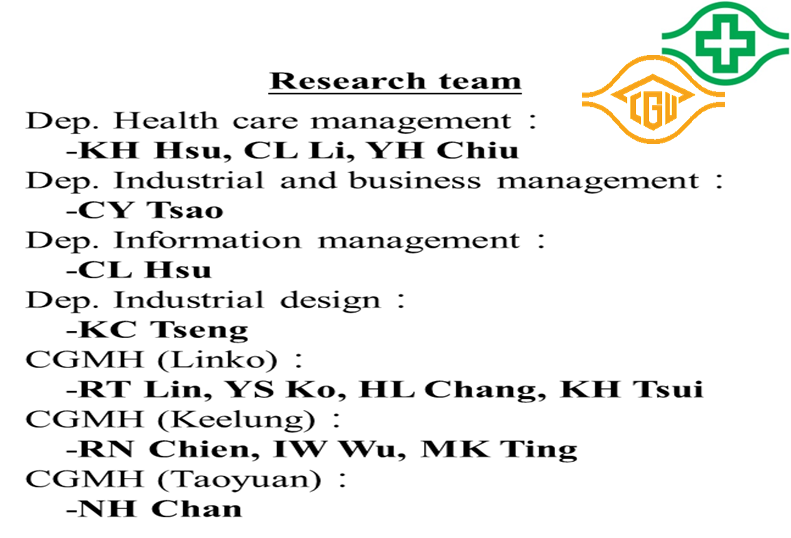Anthropometric Measurements and Aging in Community Cohort
Anthropometrics Measurements and Aging in Community Cohort
 |
||
|
Research Expertise: Epidemiology, Statistics, Health Promotion, Biotechnology Industry
College of Management, Chang Gung University
 |
 |
 |
||
| Chien-Lung Hsu, Ph.D. | Chueh-Yung Tsao, Ph.D. | Sherry Yueh-Hsia Chiu, Ph.D. |
 Research team
Research team

Conceptual Framework

General description
Aging is a multiple factorial and multi-stage process in which at least involves four dimensions including physical, psychological, social, and financial. The research team of management collaborates with CGMH clinicians to explore more comprehensively the aging-related indicators from socioeconomics, psychometrics, anthropometrics, and biomarkers within both community and hospital cohorts. There are two research arms of this research team to address human ageing issues:
(1) Socioeconomics perspectives of population aging:
(a) Explore the etiology of selected diseases based on epidemiological methodology emphasizing on interactive effects of environmental factors and social characteristics;
(b) Investigate psychosocial factors, subjective health status, self-care behaviors, and health care utilization among elderly with chronic diseases;
(c) Assess equity in health care financing and health care resource utilization in their relationship to the physiological status of elderly;
(2) Three-dimensional anthropometric study: A construction of instruments, database, and methodology for anthropometrics studies
(a) Health examination database for elderly population to follow up aging-related diseases;
(b) The association between 3D anthropometrics and chronic diseases, cognitive and behavioral changes, and aging related biomarkers;
(c) Health information system and applicability evaluation for health promotion and management of the elderly population.
This research team entails the contemporary progress, resources, and publications derived from the integrated project during the past years.
Population Aging and Socioeconomics Research Team
Research objectives:
1. substitution of morbidity and mortality in Taiwan;
2. the epidemiological study of elderly population in Taiwan;
3. association of psychosocial factors, subjective health status, self-care behaviors, and health care utilization among elderly with diabetes;
4. cost-effectiveness evaluation of dementia screening strategies;
5.health inequality among the elderly through exploiting the health/disability indices developed by the center and assessing the impacts of socioeconomic factors on health inequality and medical expenditures;
6. designing integrated care models for elderly with multiple chronic diseases, devising portfolio of incomes and assets for old age financial security, and developing innovative business models to promote the productivity of the silver-haired industry.
International collaborations:
With current collaboration with Finnish Cancer Screening Registry Center, our team will adopt valuable experiences from Europe for future policy making in Taiwan. In addition, we also work closely with Prof. Jersey Liang from School of Public Health, University of Michigan to develop innovative integrated care models for the elderly.
Past research performance:
1. the etiology of selected diseases based on epidemiological methodology emphasizing on interactive effects of environmental factors and genetic characteristics;
2. assessment of equity in health care financing, health utilization and health;
3. the study of etiological mechanism and health care management among DM patients with epidemiological methodology;
4. the epidemiological studies with community-based screening;
Three-dimensional Anthropometric Database and Welfare Design Core
Research objectives:
1. establishment of community study and health examination data warehouse: with the adoption of methods from epidemiological design and biospeciman/questionnaire management, this core laboratory will help to explore prognostic/diagnostic markers for diseases associated with aging;
2. 3D whole body scanning and 3D whole body scanning and establishment of 3D human body surface measurement data bank: the core laboratory will assist in collection of human body feature data, biophysiological indicators, cognitive and behavioral measures, and health/medical history of the elders;
3. provision of digitalized manikins and simulation systems for assessment of the safety and health efficacy of wellbeing products under simulated environment;
4. Wellbeing design and applicability assessment: R&D and designs for health care and wellbeing products feasible to aging population. This core laboratory interfaces with our University's existing core facilities to develop research, clinical application and practical design that support and expand research in aging.
3D whole body scanning, which provides a detailed body shape, has been proposed as a sophisticated tool for accurately measuring obesity status, allowing for the identification of those most at risk of metabolic syndrome (MetS), hypertension, Type 2 diabetes, and cardiovascular diseases (CVD). Body surface dimensions should not therefore be regarded as a primitive approach for describing fat distribution, rather that 3D body scanning has a potential major role to play in both epidemiological studies of risk of the MetS, and the monitoring of individual subjects in response to intervention. Digital human model (DHM) simulation systems have been utilized as an effective design tool to visualize the interaction of a human and artifact system and to evaluate the human-artifact interaction from ergonomic aspects. The wellbeing design methodology using DHM makes the iterative process of design evaluation, diagnosis and revision more rapid and economical. The research team has published dozens of international journal papers in the related fields during the past few years.
The core laboratory derived from epidemiological studies will be useful for future researches in gerontology and molecular medicine. The cross validations of biomarkers from basic medicine to epidemiological studies will further the researches in etiology, prognosis, and nature history of major diseases. Health examination data bank provides support for biomarkers of aging in MetS and CVD. 3D surface anthropometric data bank provide support for physical indices of aging, cognitive & behavior indices of aging, social & economical indices of aging, and improvement of aging indices by herbal medicine. A DHM simulation system has been used as an effective tool for wellbeing design and evaluation of products and workplaces in virtual environment. The DHM generation method proposed in the present study is of use to efficiently generate a group of DHM representing the elderly population. DHM simulation system & usability assessment provide support for physical, cognitive & behavior, social & economical, and herbal medicine related wellbeing devices/services design study.
Publications
1. Hsu, C.L., Tseng, K.C., and Chuang, Y.H. . “A Secure IRB System for Assisting the Development of Intelligent Medical Devices.” Expert Systems With Applications, Vol. 39, No. 15, November, 2012, pp. 12512-12521.
2. Chuang, Y.H., Shu, W., Hsu, K.C., and Hsu, C.L. “A Novel Communication Protocol of Wireless Sensor Networks for a Home Healthcare System in Aging Society,” Advanced Science Letters (ASL)(Accepted).
3. Chia-Lin Li, Yi-Chen Chiu, Hsing-Yi Chang, Kuang-Hung Hsu, Yuh-Bin Bai and Hui-Hsuan Wang."Association of geriatric conditions and cardiovascular diseases with disability in older adults with diabetes: Findings from a nationally representative survey".Geriatrics & Gerontology International.2012.
4. Tsao CY , Liu CC.“Asian Options with Credit Risks: Pricing and Sensitivity Analysis. “Emerging Markets Finance and Trade.2012
5. Chiou WK, Hwang JS, Hsu KH, Lin JD. “Diabetes mellitus increased mortality rates more in gender-specific than in non-gender-specific cancer patients: a retrospective study of 149,491 patients.” Experimental Diabetes Research.2012 (701643).
6. Chiu SY, Chen LS, Yen AM, Chen HH. “Population-based proband-oriented pedigree information system: application to hypertension with population-based screening data (KCIS No. 25).” J Am Med Inform Assoc. 2012; 19: 102-110.
7. Liao PJ,Chen CH, Chan HY,Tan KL,Hsu KH.” Serum Lipid Profile Could Predict the Inception and Impacts of Violent Behaviors among Acute Psychiatric Inpatients.” Chang Gung Medical Journal. 2012; 35:432-41
8. Chang YC, Ng CJ, Wu CT, Chen LC, Chen JC, Hsu KH. “Effectiveness of a five-level Pediatric Triage System: an analysis of resource utilisation in the emergency department in Taiwan.” Emerg Med J. 2012. (Epub ahead)
9. Liao PJ , Shih CP, Mao CT, Deng ST, Hsieh MC, Hsu, KH. The cutaneous adverse drug reactions: risk factors, prognosis, and economic impacts" Int J Clin Pract. 2013 Jun;67(6):576-84
10. Liao PJ, Shih CP, Mao CT, Deng ST, Hsieh MC, Hsu KH*. The cutaneous adverse drug reactions: risk factors, prognosis and economic impacts. International journal of clinical practice. 2013; 67(6):576-584. (SCI)
11. Shih CP, Lin YC, Chan YY, Hsu KH*.Employing infectious disease physicians affects clinical and economic outcomes in regional hospitals: Evidence from a population-based study. Journal of Microbiology, Immunology and Infection. 2013. (SCI)
12. Hsu KH, Shih CP, Liao PJ. Waist-to-thigh ratio is a predictor of internal organ cancers in humans: findings from a cohort study. Annals of Epidemiology. 2013;23(6):342-348.(SCI)
13. Wu IW, Hsu KH, Lee CC, Sun CY, Hsu HJ, Hung MJ, Wu MS. Re-evaluating the predictive roles of metabolic complications and clinical outcome according to eGFR levels – A four-years prospective cohort study in Taiwan. BMC Nephrology. 2013;14(92).(SCI)
14. Hung MY, Hsu KH, Hu WS, Chang NC, Huang CY, Hung MJ. Gender-Specific Prognosis and Risk Impact of C-Reactive Protein, Hemoglobin and Platelet in the Development of Coronary Spasm. Int. J. Med. Sci. 2013; 10(3):255-264.(SCI)
15. Maa SH,Wang CH, Hsu KH, Lin HC, Yee B, MacDonald K, Abraham I. Acupressure Improves the Weaning Indices of Tidal Volumes and Rapid Shallow Breathing Index in Stable Coma Patients Receiving Mechanical Ventilation: Randomized Controlled Trial. Evidence-Based Complementary and Alternative Medicine. 2013.(SCI)
16. Hung MJ, Hsu KH, Hu WS, Chang NC, Hung MY. C-Reactive Protein for Predicting Prognosis and Its Gender-Specific Associations with Diabetes Mellitus and Hypertension in the Development of Coronary Artery Spasm. PLoS One.2013;8(10): e77655
17. Chia-Lin Li*, Yi-Chen Chiu, Hsing-Yi Chang, Kuang-Hung Hsu, Yuh-Bin Bai and Hui-Hsuan Wang. Association of geriatric conditions and cardiovascular diseases with disability in older adults with diabetes: Findings from a nationally representative survey. Geriatrics and Gerontology International.2013;13(3) 563-570. (SCI)
18. Chia-Lin Li, Hsing-Yi Chang, Chih-Cheng Hsu, Jui-fen Rachel Lu, Hsin-Ling Fang. 2013, 13: "Joint predictability of health related quality of life and leisure time physical activity on mortality risk in people with diabetes" BMC Public Health, 67. (SCI)
19. Tseng, K.C., Hsu, C.L., and Chuang, Y.H., "Designing an Intelligent Health Monitoring System and Exploring User Acceptance for the Elderly," Journal of Medical Systems, Vol. 37:9967, No. 6, 2013. <SCI: 1.783 (2013), 36/83 in HEALTH CARE SCIENCES & SERVICES>
20. Chen LS, Yen AM, Fraser CG, Chiu SY, Fann JC, Wang PE, Lin SC, Liao CS, Lee YC, Chiu HM, Chen HH. Impact of faecal haemoglobin concentration on colorectal cancer mortality and all-cause death. BMJ Open. 2013 Nov 7;3(11):e003740. doi: 10.1136/bmjopen-2013-003740.
21. Yeh YP, Hu TH, Cho PY, Chen HH, Yen AM, Chen SL, Chiu SY, Fann JC, Su WW, Fang YJ, Chen ST, San HC, Chen HP, Liao CS; Changhua Community‐based Abdominal Ultrasonography Screening Group. Evaluation of abdominal ultrasonography mass screening for hepatocellular carcinoma in Taiwan. Hepatology. 2013 Aug 26. doi: 10.1002/hep.26703.
22. Kevin C. Tseng, Bor-Shyh Lin*, Lun-De Liao and Yu-Te Wang. Development of wearable mobile electrocardiogram monitoring system by using novel dry foam electrodes.IEEE Systems Journal. 2013. Vol. 8, No. 3, pp. 900-906.
23. Kevin C. Tseng, Alice M. Wong, Chien-Lung Hsu*, Tsai-Hsuan Tsai, Chang-Mu Han and Ming-Ren Lee. The iFit: An integrated physical fitness testing system to evaluate the degree of physical fitness of the elderly. IEEE Transactions on Biomedical Engineering. 2013. Vol. 60, No. 1, pp. 184-188.
24. Tsai-Hsuan Tsai, Alice M. Wong, Chien-Lung Hsu and Kevin C. Tseng*. Research on a community-based platform for promoting health and physical fitness in the elderly community. PLOS One. 2013. Vol. 8, No. 2, pp. e57452.
25. Hui-Hsuan Wang, Ji-Tian Sheu, Yea-Ing Lotus Shyu, Hsing-Yi Chang, Chia-Lin Li*. Geriatric conditions as predictors of increased number of hospital admissions and hospital bed days over one year: findings of a nationwide cohort of older adults from Taiwan. Archives of Gerontology and Geriatrics (2014 Jul)59(1): 169-174 (*Corresponding Author) (SCI)
26. Chia-Lin Li†, Ji-Tian Sheu†, Ting-Ann Wang, Yu-Ping Wen, Minston Chao, Hsing-Yi Chang. The relationship between healthy lifestyle and hospital utilization among adults with diabetes: results from a national cohort in Taiwan. Asia-Pacific Journal of Public Health (2014, published online 24 February 2014) (†Equal contribution) (SSCI)
27. Chiu SY, Lai H, Yen AM, Fann JC, Chen LS, Chen HH. Temporal sequence of the bidirectional relationship between hyperglycemia and periodontal disease: a community-based study of 5,885 Taiwanese aged 35-44 years (KCIS No. 32). Acta Diabetol. 2014 Jul 3. [Epub ahead of print]
28. Yen AM, Chen SL, Chiu SY, Fann JC, Wang PE, Lin SC, Chen YD, Liao CS, Yeh YP, Lee YC, Chiu HM, Chen HH. A new insight into fecal hemoglobin concentration-dependent predictor for colorectal neoplasia. Int J Cancer. 2014 Sep 1;135(5):1203-12.
29. Hsu CL, and Lin YL. Improved Migration for Mobile Computing in Distributed Networks. Computer Standards & Interfaces.2014;36(3) 577-584.
30. Hsu, C.L., and Lin, H.Y. Convertible Authenticated Encryption Scheme with Hierarchical Access Control. Applied Mathematics & Information Sciences. 2014;8(3) 1239-1246.
31. Hsu, C.L. and Lin, H.Y. Universal Forgery Attack on a Strong Designated Verifier Signature Scheme. The International Arab Journal of Information Technology. 2014;11(5).
32. Hsu, C.L. and Lin, H.Y. Provably Secure Message Recovery Limited Verifier Signature Scheme with Low Cost. Information-An International Interdisciplinary Journal. 2014;17(4) 1187-199.
33. Lu, C.F., Hsu, C.L., Lin, H.Y., and Su, C.H. A Robust Convertible Multi-Authenticated Encryption Scheme with One-Way Hash Function. International Journal of Future Computer and Communication. 2014;3(5) 315-318.
34. Lin, Y.L., Hsu, C.L., and Chuang, Y.H. A Robust Time-Bound Hierarchical Key Assignment Scheme. International Journal of Future Computer and Communication. 2014;3(5) 337-340.
35. Chien-Lung Hsu, Yu-Hao Chuang and Pei-Ling Tsai. Design of Pairing-Based Proxy Signcryption System Model for Online Proxy Auctions. 2014;43(5) 381-389.
36. Seal CJ, Ng CJ, Yen HT, Wong YC, Hsu KH*, Seak CY, Seak. Performance Assessment of SAPS II, APACHE II score and SOFA score in Predicting the Outcomes of Adult Patients with HPVG in the ED. American Journal of Emergency Medicine. 2014.
37. Seak CJ, Hsu KH, Wong YC, Ng CJ, Yen HT, Seak CY, and Seak CK. The prognostic factors of adult patients with hepatic portal venous gas in the ED. American Journal of Emergency Medicine. 32(2014) 972-975.
38. Chu SM, Yang MC, Hsiao HF, Hsu JF, Lien R, Chiang MC, Fu RH, Huang HR, Hsu KH, Tsai MH. One-week versus 2-day ventilator circuit change in neonates with prolonged ventilation: cost effectiveness and impact on ventilator associated pneumonia. Infection Control & Hospital Epidemiology. 2014.
39. Lin CC, Liao SC, Shih CP, Hsu KH*. QTC prolongation as a useful prognostic factor in acute paraquant poisoning. The Journal of Emergency Medicine. Vol. 47,No. 4, pp401-407. 2014.
40. Chang YC, Ng CJ*, Wu CT, Chen LC , Chen JC, Hsu KH*. Pediatric overtriage as a consequence of the tachycardia responses of children upon emergency department admission. American Journal of Emergency Medicine. 33(1). 2015. 1-6. (SCI)
41. Liao PJ, Lin ZY, Huang JC, Hsu KH*. The relationship between type 2 diabetic patients' early medical care-seeking consistency to the same clinician and health care system and their clinical outcomes. Medicine. Feb 2015;94(7):e554. (SCI)
42. Chia-Lin Li, Ji-Tian Sheu, Ting-Ann Wang, Yu-Ping Wen, Minston Chao, Hsing-Yi Chang. The relationship between healthy lifestyle and hospital utilization among adults with diabetes: results from a national cohort in Taiwan. Asia-Pacific Journal of Public Health (2015 Apr) 27(3): 303-313 (SSCI)
43. Kevin C. Tseng, Bor-Shing Lin, Alice May-Kuen Wong and Bor-Shyh Lin* (2015/03) “Design of a mobile brain computer interface-based smart multimedia controller”. Sensors. Vol. 15, No 3, pp. 5518-5530. (SCI; IF=2.245, 2014) (10/56 in Instruments & Instrumentation, 2014, Q1)
44. Chiung-Wei Huang, Yen-I Chiang, Chien-Lung Hsu,* Cheng-Yuan Chang,. Design and User Acceptance Evaluation of An Intelligent Electronic Navigation Crutches System for Elderly Mobile Healthcare. Submitted to International Journal of Distributed Sensor Network.
45. Chiu, S. Y. H., Lai, H., Yen, A. M. F., Fann, J. C. Y., Chen, L. S., & Chen, H. H. (2015). Temporal sequence of the bidirectional relationship between hyperglycemia and periodontal disease: a community-based study of 5,885 Taiwanese aged 35–44 years (KCIS No. 32). Acta diabetologica, 52(1), 123-131.
46. Hsu CL, Chuang YH , Kuo CL. A Novel Remote User Authentication Scheme from Bilinear Pairings via Internet Wireless Personal Communications.Wireless Personal Communications. 83:163-174, 2015. (SCI)
47. Chien HY, Wu TC, Hsu CL. RFID Authentication with Un-traceability and Forward Secrecy in the Partial-Distributed-Server Model, IEICE TRANSACTIONS on Information and Systems, Vol. E98-D, No.4 pp.750-759, April 2015. (SCI)
48. Kevin C. Tseng, Sung-Hui Tseng and Hsin-Yi Cheng*.“Design, development, and clinical validation of therapeutic toys for autistic children”. The Journal of Physical Therapy Science. Vol. **, No. *, pp. **-**. (2016/04 Online) (SCI)
49. Bor-Shyh Lin, Alice M. Wong, Kevin C. Tseng*.“Community-based ECG monitoring system for patients with cardiovascular diseases”. Journal of Medical Systems. Vol. **, No. **, pp. **-**. (2016/01 Online) (SCI)
50. Liao PJ, Lin TY, Wang TC, Ting MK,Wu IW, Huang HT, Wang FC, Chang HC, Hsu KH*. Long-term and interactive effects of pay-for-performance interventions among diabetic nephropathy patients at the early chronic kidney disease stage. Medicine.2016.(accepted) (SCI)
51. Lin CC, Hung DZ, Chen HY, Hsu KH* The Effectiveness of Patient-tailored Treatment for Acute Organophosphate Poisoning. Biomedj. 2016.(accepted) (SCI)
Contact: Ms. Ye #5250
yellow@mail.cgu.edu.tw
